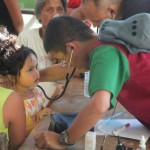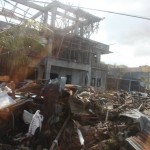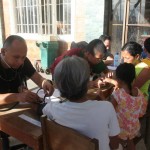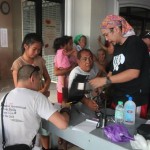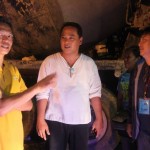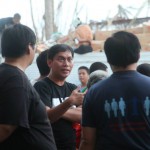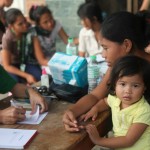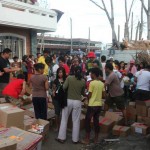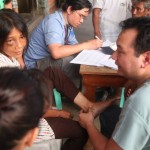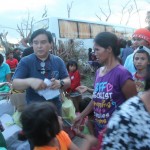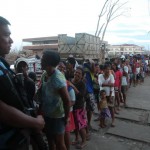Palo, Leyte, a third class municipality with a population of 62,727 (2010 census), was hard hit by typhoon Haiyan. By day 2, there were 33 confirmed mortalities due to the violent wind and storm surge. Palo is the site of the University of the Philippines School of Health Sciences, one of the top midwifery schools in the country that train socially conscious community health workers. Some of them eventually become nurses and doctors who stay in the rural areas to serve the needy.
A land trip was planned. Complicating the trip were the long wait for the ferry from Matnog, Sorsogon (southern tip of Luzon) to Allen Samar and the security problems (communist activity and banditry) on the road along Samar, particularly just before the San Juanico Bridge (connects southern tip of Samar island to Leyte).
Repacking of “family relief packs” and “hygiene kits” were done by various volunteers from University of the Philippines Manila and non-governmental organizations who trooped to the Pahinungod office and nearby Nurses’ Home in the Philippine General Hospital campus. The following were prepared and eventually distributed:
- 1500 family relief packs (2 kg. rice, canned goods, instant noodles, instant coffee, candles, matches, biscuits, candies/chocolates, 1 liter bottled water, and water purification tabs, all in an eco-friendly bag)
- 993 hygiene kits – (bath soap, toothpaste, cotton balls/buds, face towel, toothbrushes, toilet paper, sanitary napkin, diapers, alcohol, and betadine, all in a small handy bag).
- 400 sleeping mats
- 400 mosquito nets
- 120 coloring books, 120 packs of crayons, and 120 toys (colored rubber balls)
The all-volunteer team, led by Pahinungod Director, trauma surgeon and PHI Brod, Dr. Eric Talens, was composed of:
- 11 doctors, 1 dentist, 2 EMT’s and Information officer from Manila
- 2 volunteers at the site who were typhoon victims themselves
- 5 mountaineers who brought their own supplies and provided housekeeping chores for the whole team (cooking, cleaning, and setting camp)
The team was prepared to be self-sufficient with their own food and water for the entire trip. The 8-vehicle caravan included a truck to transport the relief goods and medical supplies and a bus to bring the personnel. A separate team of 15 personnel in 6 vehicles joined en route, to provide security as the team traversed the danger areas. This group was self-sufficient in terms of food and water. All Pahinungod volunteers are insured. They fill out personal data sheets for beneficiaries just before each mission. The safety of the volunteer is paramount in any mission.
The Team left Philippine General Hospital at 11 p.m. of Nov. 17, 2013. The long queue for the ferry boats measured at least 12 kilometers. The caravan was allowed to bypass this through previous special arrangements. In spite of this, there was a 7-hour wait at the port due to the heavy vehicular and passenger traffic in the ferries. Provided with additional security (1 vehicle from Armed Forces of the Philippines) from Allen port in Samar, the team convoy headed for Leyte and arrived at Palo after a 29-hour journey.
Palo, like Tacloban, was virtually a ghost town. Many inhabitants, with resources and relatives in other areas had already evacuated. The lack of food, water and electrical power, had shut down most of the operations in the municipality including the barely functioning Local government units.
The medical mission and relief distribution were conducted at the grounds of the Sacred Heart Seminary in Palo, coordinated with the mayor’s office. The mission started at about 2:30 p.m. in the afternoon and continued only until sundown, since there was no electricity. Approximately 500 patients were treated.
Relief distribution, was carried out until 7 p.m. at night when all relief items were distributed. All volunteers, including bus and truck drivers as well as local volunteers were involved in the distribution.
The whole mission crew and security teams billeted for the night in the Iglesia ni Kristo grounds in Palo, Leyte. where they were allowed to park the vehicles, set-up camp, cook and eat their evening meal and breakfast, as well as use the toilet and bath facilities.
The team left early the next morning to deliver the residual medications to Eastern Visayas Medical Center in Tacloban. The hospital staff there was short on food since their supplies were taken by looters. The team left all the remaining food and water with the hospital staff when they left Tacloban.
The trip back to Manila took less than 24 hours and was uneventful, except for difficulty in docking back at Matnog port due to the rough sea. The team was back in Manila at 2 p.m., Nov. 21, 2013.
